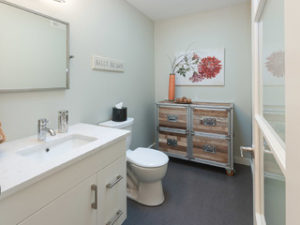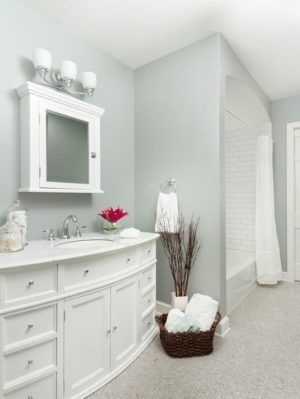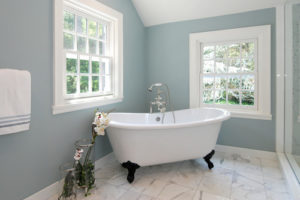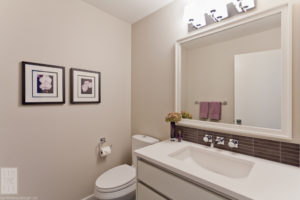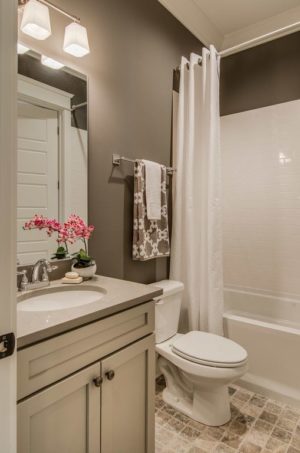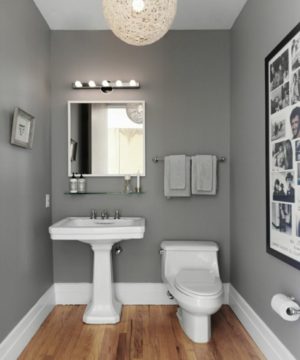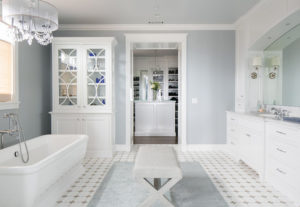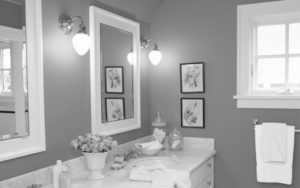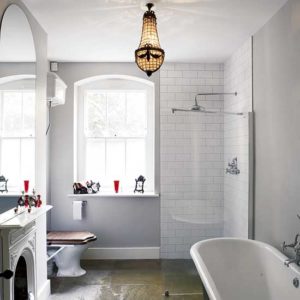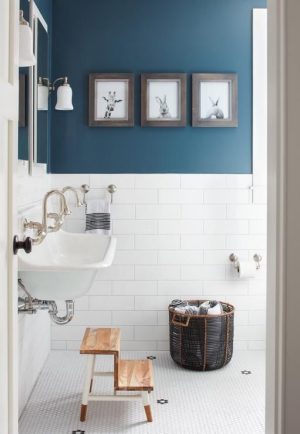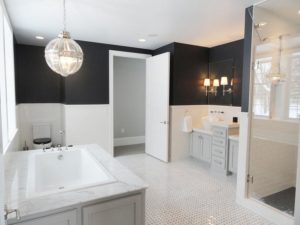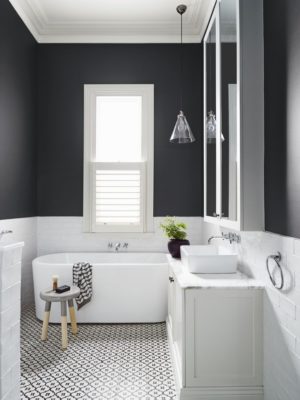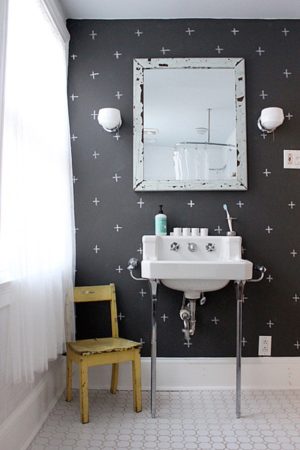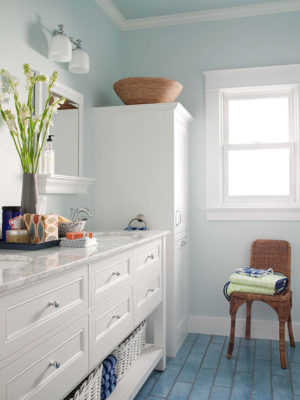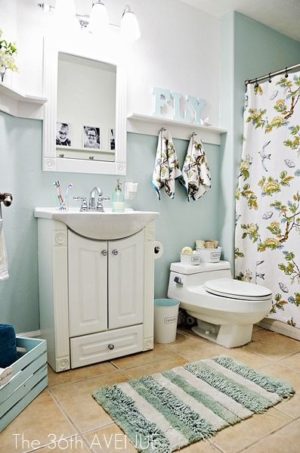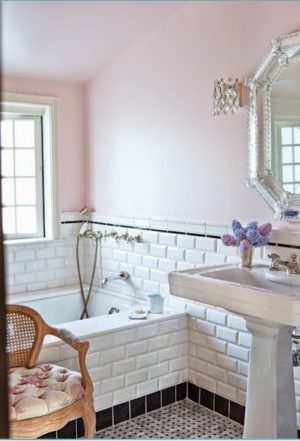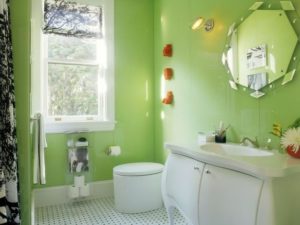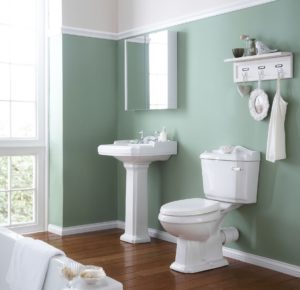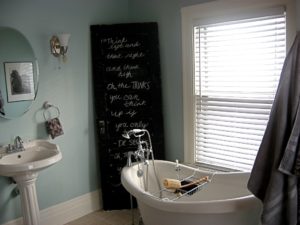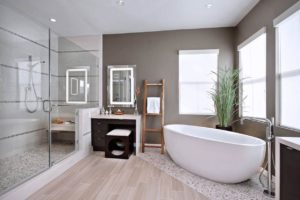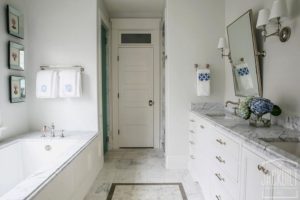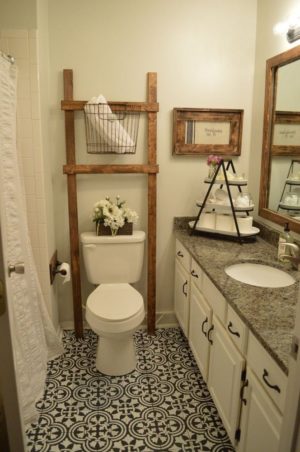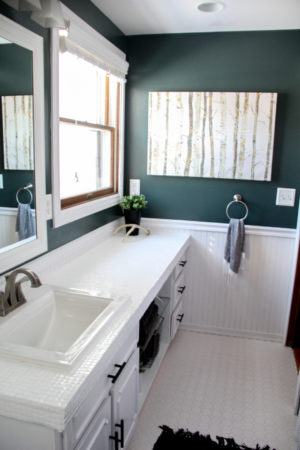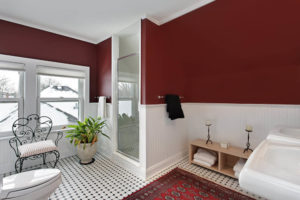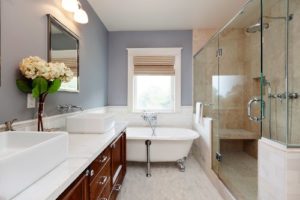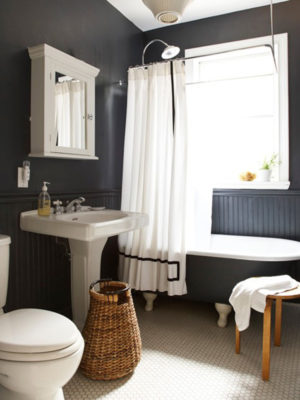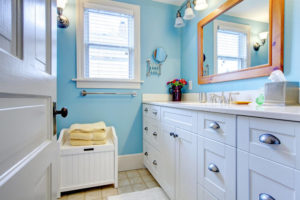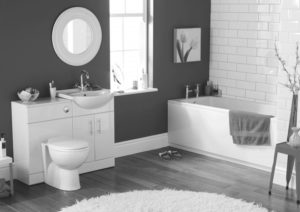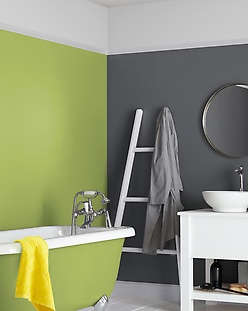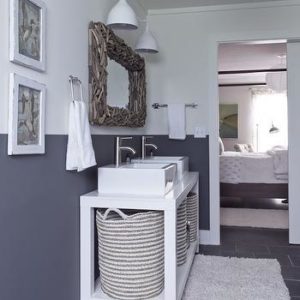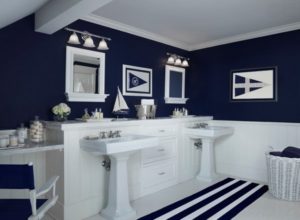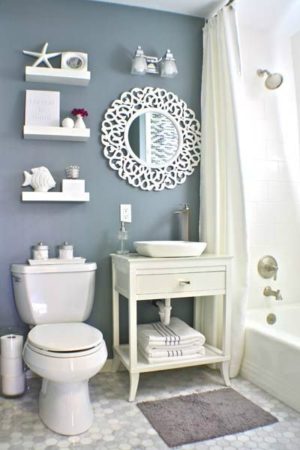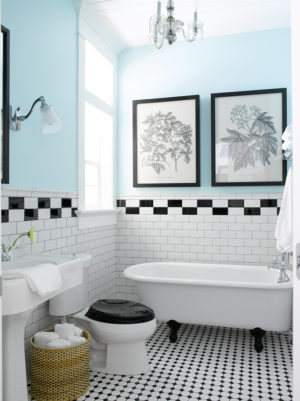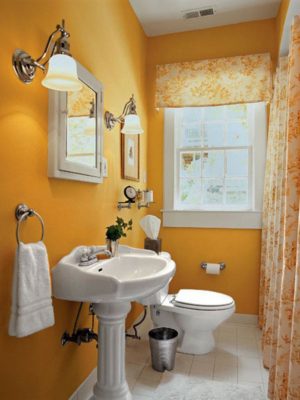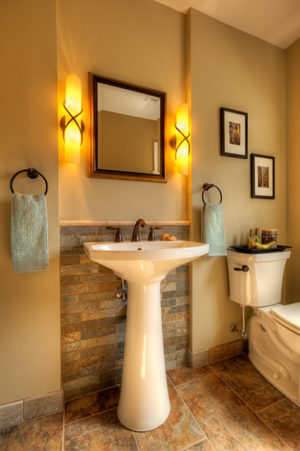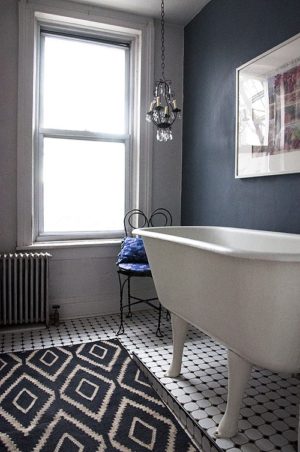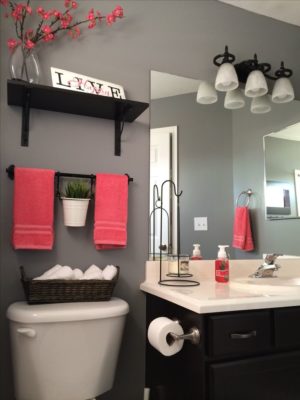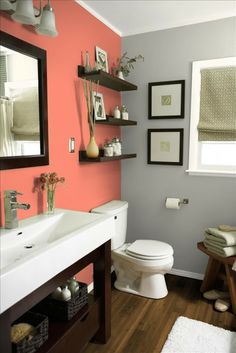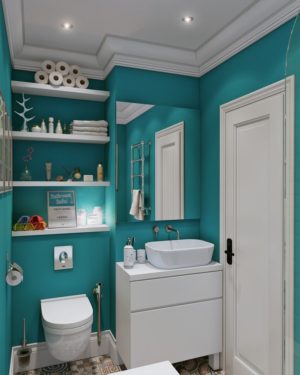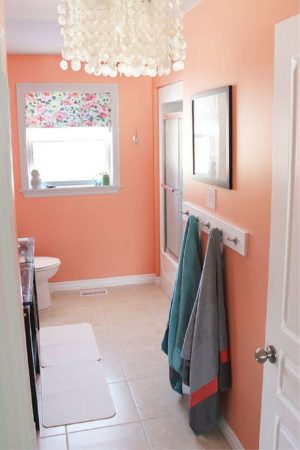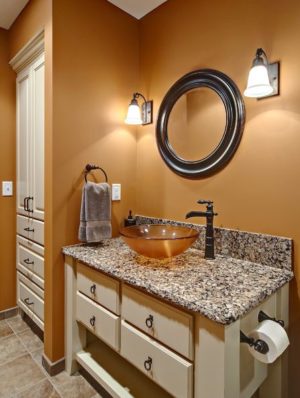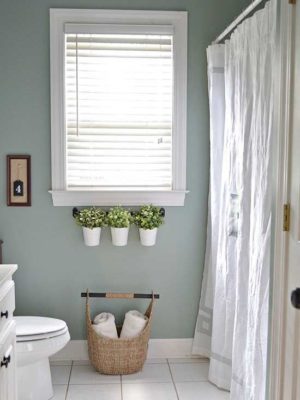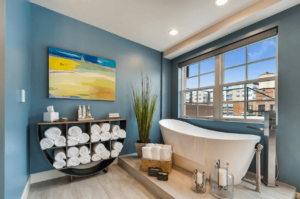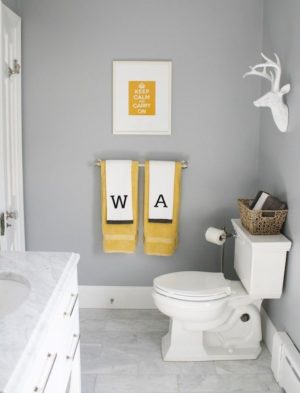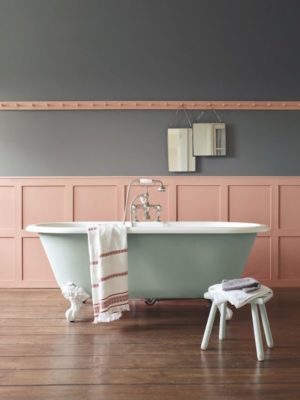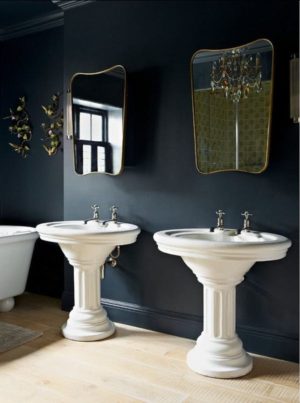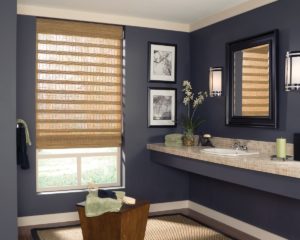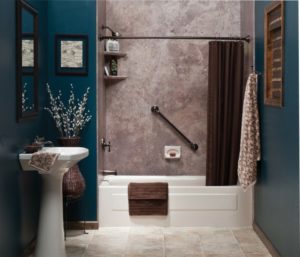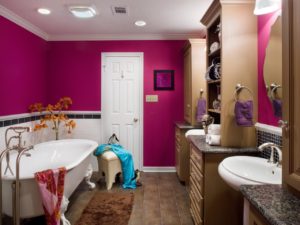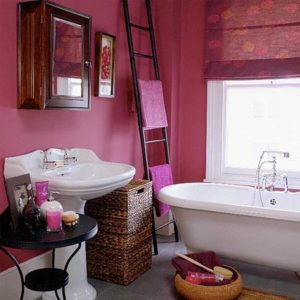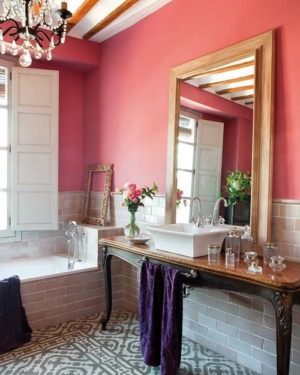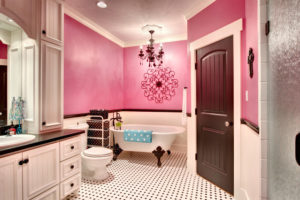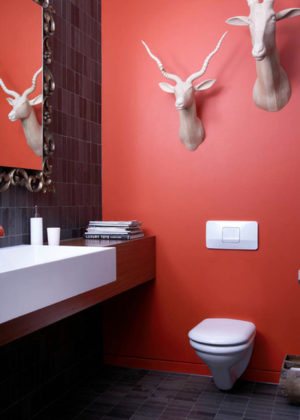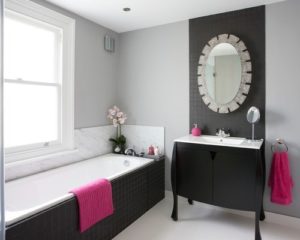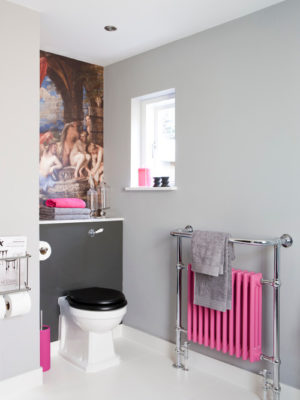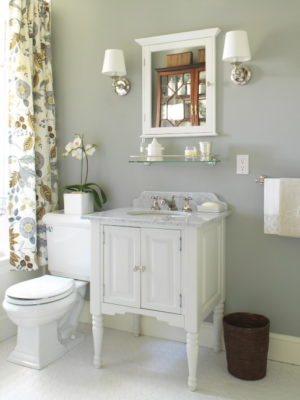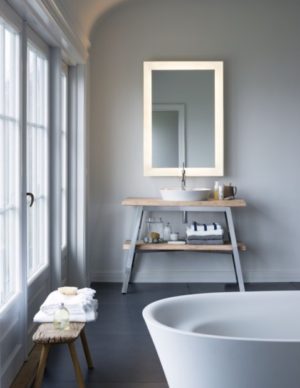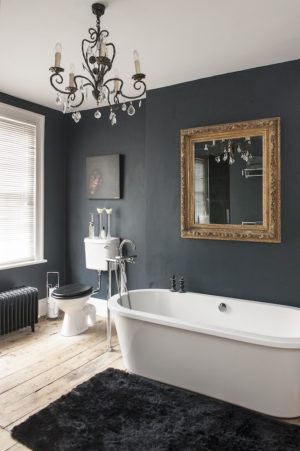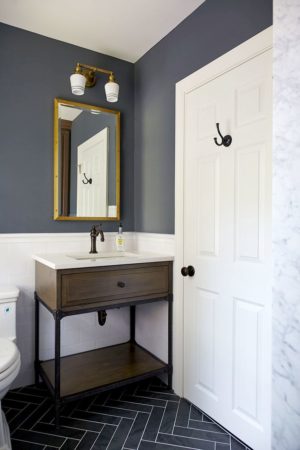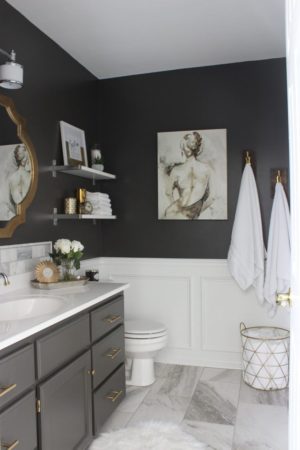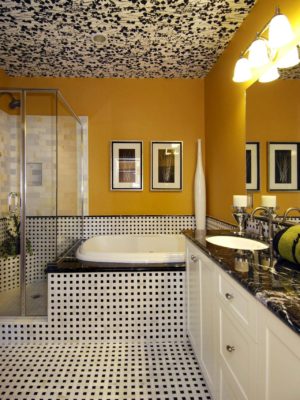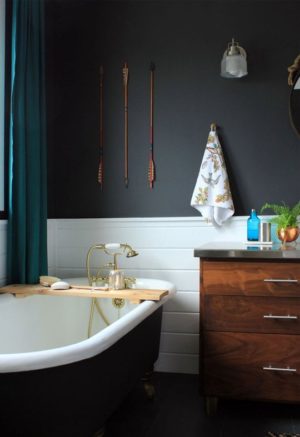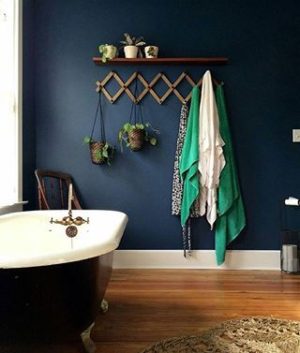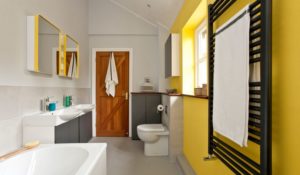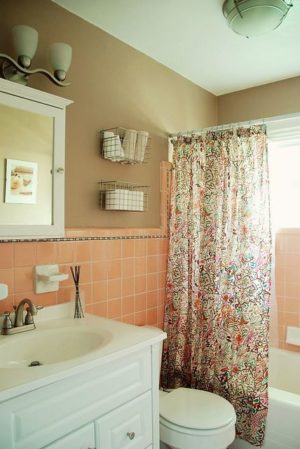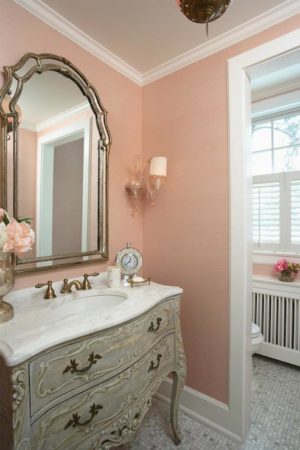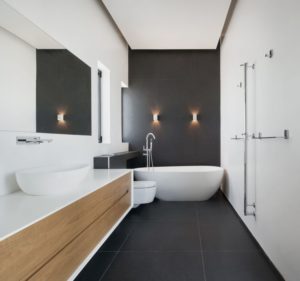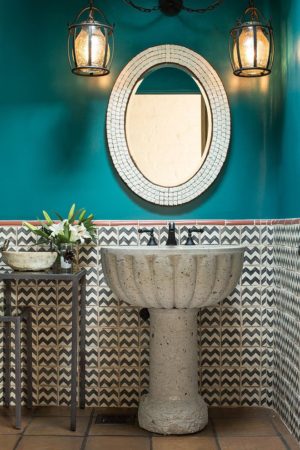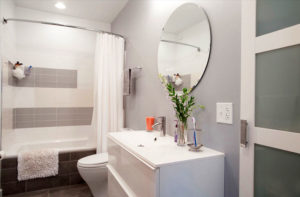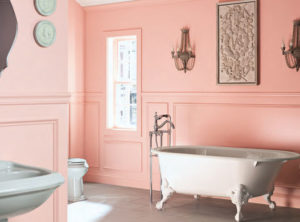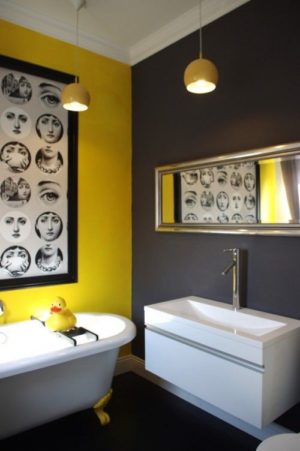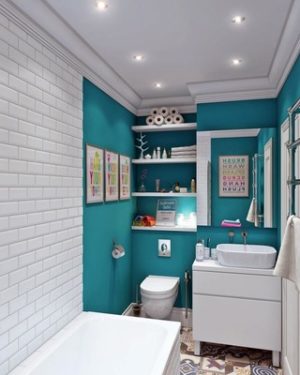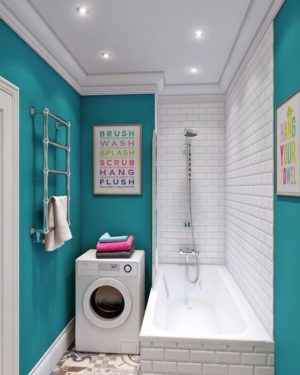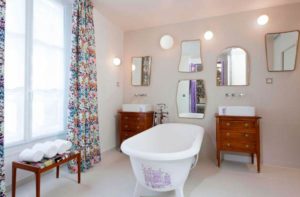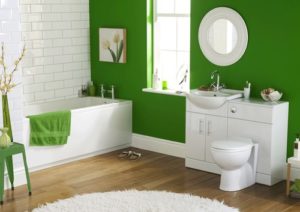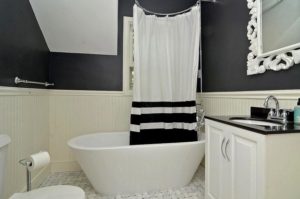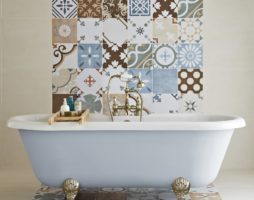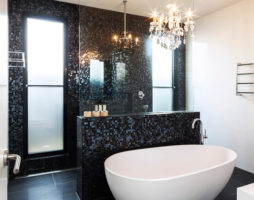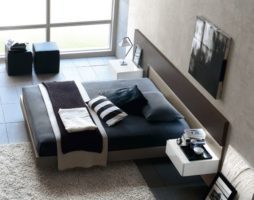Bathroom renovation is a very complex and expensive process that requires a competent approach to the selection of building materials and tools. The most budgetary option can be performed by choosing, as an alternative to tiles, coating the surfaces of the room with paint.
This material will not only save time and money, but will also help create a unique bathroom interior using rich and saturated colors, adding color to which will create the desired shade.

Paint will help create a unique bathroom interior
The paint is used on those areas of the bathroom that do not come into contact with water. It is advisable to close the places directly adjacent to the bathtub or sink with glass panels or tiles. In the bathroom, there are always large temperature fluctuations and high humidity, so you need to select paints that can endure extreme conditions in the room. The right choice of material will help to make a durable and resistant coating.
back to index ↑Choosing bathroom paint
Before heading to the store for materials, you should consider the pros and cons of all types of paint, determine which material to choose for bathroom renovation, so that the coating is artistic and durable.
When choosing paints for bathroom renovation, you should focus on products from leading manufacturers, they are quite expensive, but they will create an excellent high-quality coating. The most important properties of bathroom paints are water resistance and protection against fungi. There are several types of waterproof paints.
Water-based paints
Specialists in the field of repair advise using water-based compositions as a coating for bathroom walls, noting a number of advantages of this material:
relatively low cost;
- lack of sharp unpleasant odors;
- ease of application;
- environmental safety;
- fast drying;
- preservation of color under the influence of the sun's rays.

Water-based paint has a relatively low cost
Decorative water-based paints have sufficient viscosity, therefore, a surface painted with water-based compositions provides designers with a wide field for creating interesting, original design compositions. With the help of various tools, outstanding wall paintings are created. The inclusion of coloring pigments in a water-based emulsion allows you to get a shade of any color that is ideal for the intended bathroom interior.
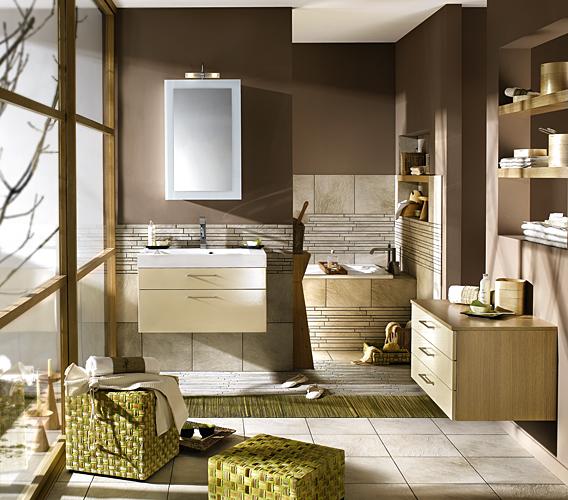
Water-based paint allows you to get a shade of any color
Water-based paints can create glossy and matte surfaces, so before working with them, you should consider the type of surface and carefully select primers. For areas that are constantly in contact with water, water-based paint is not recommended.If, nevertheless, there is such a need, then mixtures are chosen that give a glossy finish, they are more resistant to mechanical stress.
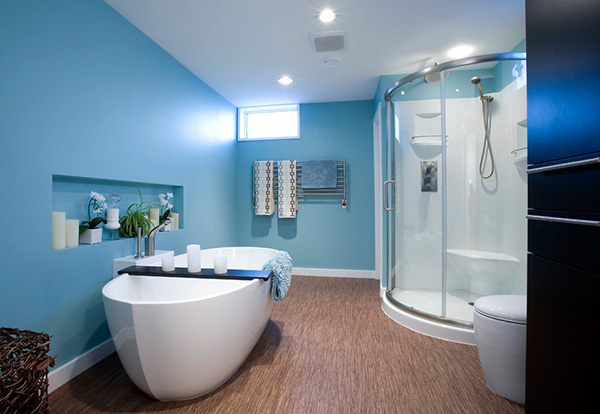
Glossy water-based paint is more resistant to mechanical stress
Water-based paints are easily washed off under mechanical action with a moistened object, therefore, dirt should not be removed with a sponge with soapy water, it is better to wipe the dirt dry. But this has an advantage: if necessary, any contamination is easily removed and repainted without difficulty.
latex paints
A popular material for bathroom renovations are latex mixes. They are considered an ideal coating for rooms with high humidity due to their excellent characteristics:
- high elasticity of the material, allowing
- cover all sorts of small chips, cracks;
- create a durable coating resistant to mechanical stress;
- give a presentable appearance to the walls;
- do not emit a strong odor during operation;
- create a film that protects the surface from contamination;
- used in any room;
- depending on the composition, they dry in a maximum of 2 hours.
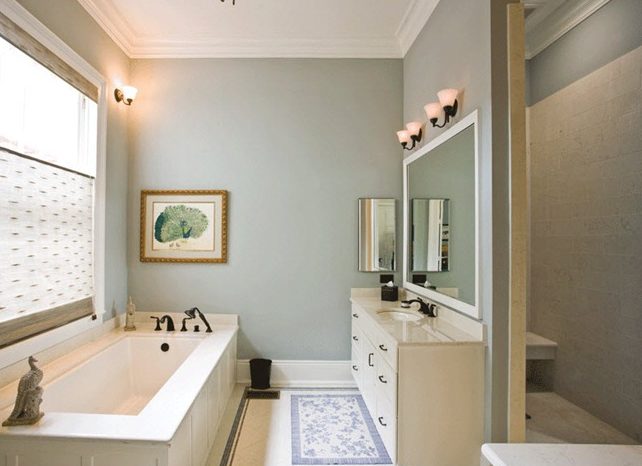
Latex paint creates a film that protects the surface from contamination
Latex paints do not contain antifungal components, therefore, before work, the surface of the bathroom walls should be treated with a special disinfecting primer.
The downside of the latex coating is poor tolerance to low temperatures, under the influence of which the surface may crack. Sunlight negatively affects the surface painted with latex paints; under ultraviolet rays, the original color loses its brightness and juiciness. Latex paints cannot be considered a budget option for bathroom renovations. The cost of these mixtures is an order of magnitude higher than other water-based paints.
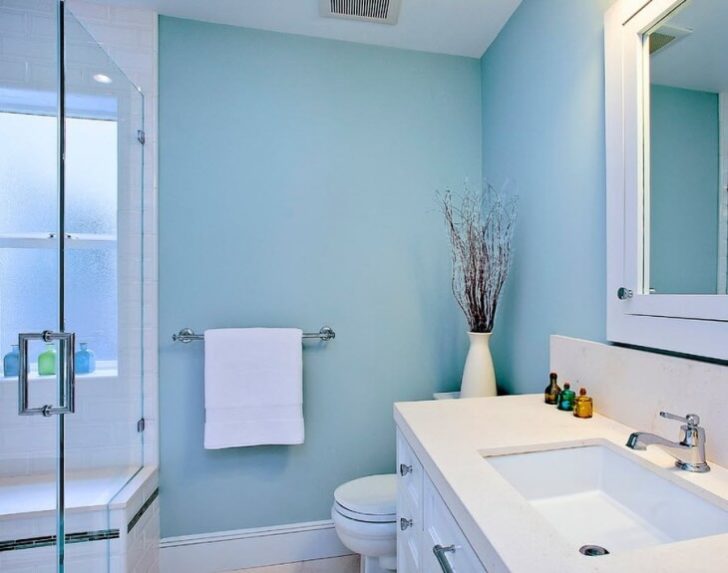
Latex bathroom paint does not contain antifungal agents
Acrylic paints
Acrylic paint for bathroom walls, which belongs to water-dispersion compositions, is considered ideal from all points of view. Painting the walls in the bathroom provides a number of advantages:
- a wide range of different shades and colors;
- water-repellent properties allow you to paint areas that have direct frequent contact with water;
- resistance of acrylic coating to pollution;
ease of application during repair; - has a characteristic, but not pungent odor that does not cause discomfort when stained;
- dirt is easily washed off with wet materials without harming the surface;
- contain antifungal components that prevent the development of fungi and
- preventing the appearance of mold;
- ideal pre-treatment is not required, since the viscosity of the composition allows you to hide small cracks.
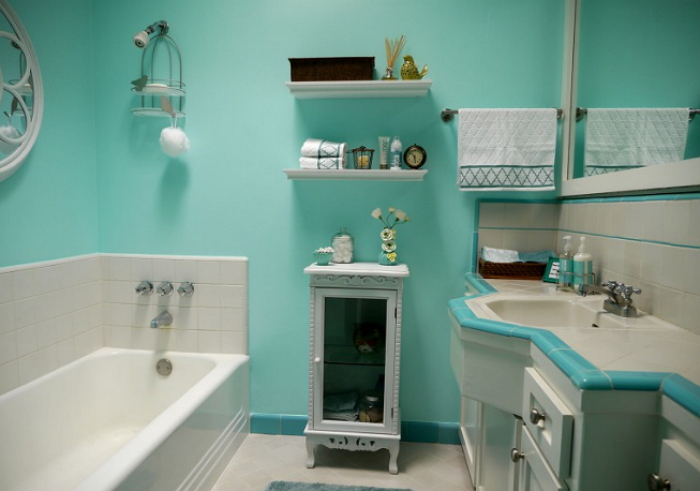
Acrylic paint prevents mold
Due to the low cost compared to other analogues of water-based paints, acrylic paints are now the most sought-after material for bathroom walls.
silicone paints
Moisture-resistant paints based on silicate and silicone have appeared on the building materials market relatively recently, but have already become popular due to their unique physical characteristics:
- silicone coating does not let water through;
- resistant to various pollution;
- has vapor-tight properties;
- when painting the walls in the bathroom hides even deep cracks and potholes on the surface.
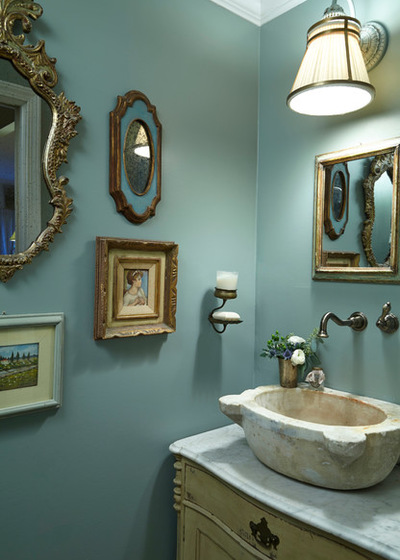
Silicone paint hides all surface imperfections
Water-based silicone paint for bathroom walls is the most suitable option, but has a significant drawback in the form of a rather high cost.
It is not recommended to use water-based paint based on PVA glue for bathroom renovation, as it is intended for dry rooms.In the bathroom, only the ceiling can be covered with it.
Chlorine rubber paint
This type of bathroom wall covering is considered the most practical and reliable, capable of replacing tiles or mosaics. He will perfectly cope with the task and does not need preventive work for a long time.
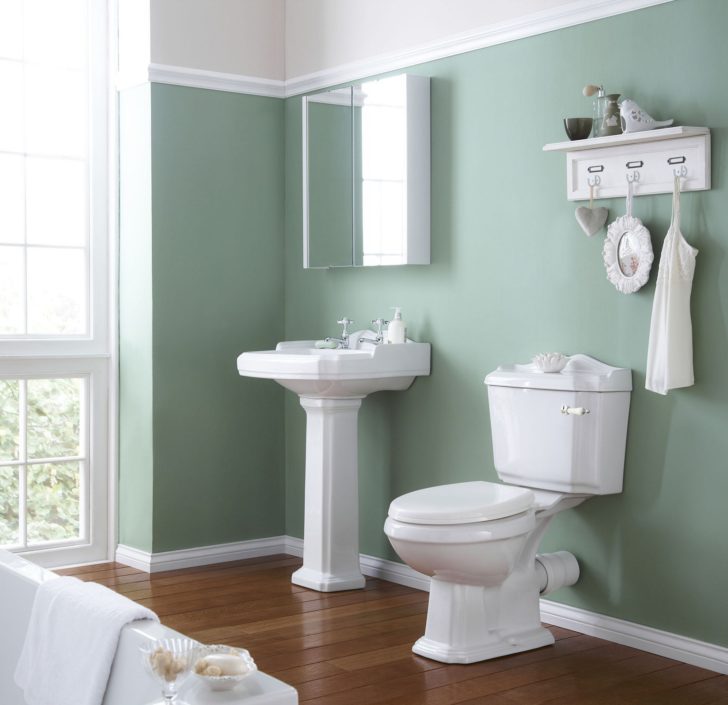
Chlorinated rubber paint is considered the most practical and reliable coating.
The main advantage of chlorinated rubber coating is its durability:
- high degree of protection against moisture;
- withstands constant contact with water, perfectly protecting the surface;
- well tolerates exposure to ultraviolet rays, practically without changing its color;
- with the right selection of the composition, it can be used as a covering for the walls of the bathroom;
- does not contain toxic and harmful substances, although it is not recommended to paint containers with drinking water.
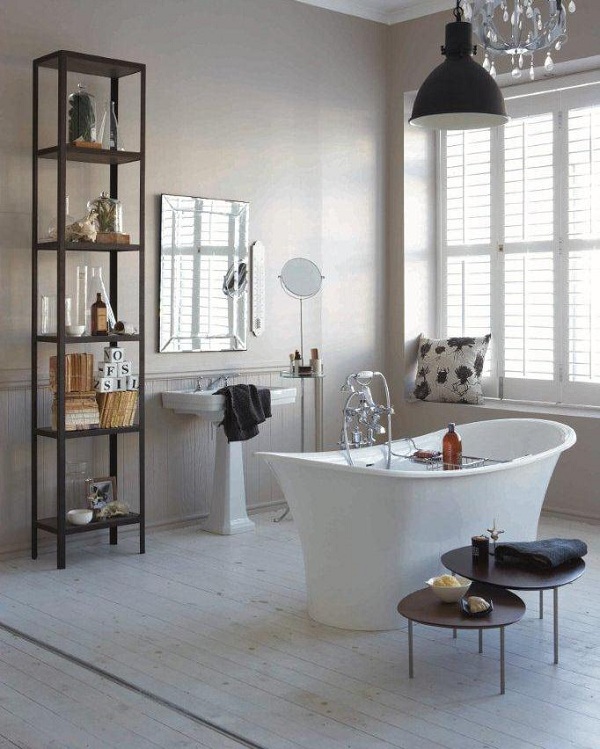
Chlorine rubber paint has a high degree of protection against moisture
The chlorinated rubber coating is applied only to metal or cement surfaces thoroughly cleaned of the old coating, preliminary priming and puttying are excluded.
Painting the walls in the bathroom with chlorinated rubber paints will cost a pretty decent amount. At least three layers of material are applied to the surface, a special composition is required as a solvent, but the result, service life and coating characteristics fully justify the amount spent.
Alkyd enamel
Any type of alkyd enamel will work as a wall covering in a bathroom. The tension of the enamel film perfectly repels moisture, allowing you to easily wet the walls. Other advantages of alkyd enamels include:
- no fading when exposed to sunlight;
- long service life of the coating;
- excellent protection of metal products against corrosion;
- quick drying during repair work;
- a transparent layer that perfectly hides the unevenness of the walls.
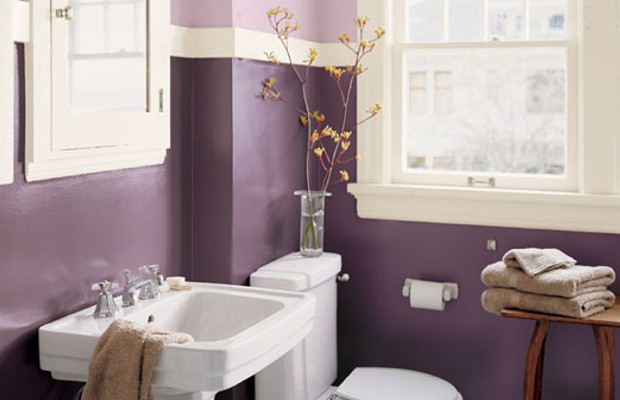
Alkyd enamel allows wet cleaning of walls
Among the minuses there is a sharp unpleasant odor and the requirements for careful preparation of the walls for painting with alkyd enamel. The surface should not crumble; before painting the walls in the bathroom, they are coated with a primer. For excellent results, several layers of enamel are applied to the surface.
Oil paint
A budget and affordable option, but it has more disadvantages than advantages: a long drying period, a strong smell, the difficulty of removing it from the walls if repairs are necessary. In addition, this paint creates an airtight film, which is unacceptable for a bathroom, since the surface must breathe, so that perspiration is not created, creating a favorable environment for bacteria.
Oil paint can cover the floor of the bathroom, where an impervious film will come in handy. It is rarely chosen for walls, as it tends to quickly crack and crumble.
back to index ↑Paint in the interior of the bathroom
Once you have decided on the type of coverage, it's time to think about the desired color of the bathroom. The choice of colors depends entirely on the style of the bathroom, your taste and the size of the room. In order for the bathroom paint to fit perfectly into the interior, the chosen shade should not only be optimally combined with the color of the sanitary ware, but also visually change the space, correct defects in the layout of the room.
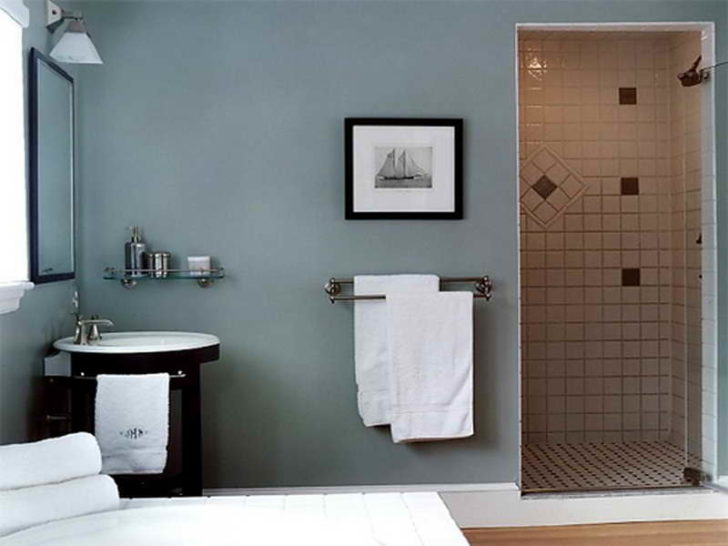
The color of the bathroom paint should be in harmony with the interior.
Compact bathrooms require the use of light shades of coating, as this will help to visually push the walls apart. Pastel colors are ideal for sanitary ware and bathroom furniture, as most often it comes in white. Light shades are best used on perfectly flat walls, otherwise all flaws will be noticeable.
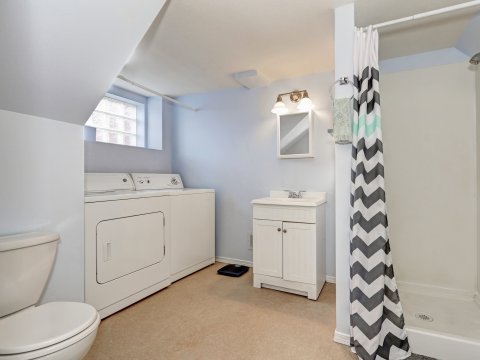
Light-colored paint will visually enlarge the space.
Minor flaws can be hidden with textured paints of light shades.You can add variety to the monotony of pastels with the help of contrasting tones.
Spacious rooms give the designer free rein for boundless imagination: playing with contrasts, using different patterns, types of finishes. Bathrooms with geometric patterns in the form of zigzags, rhombuses, triangles look original and interesting. This interior gives the bathroom individuality. It should only be remembered that on dark surfaces the traces left by soap splashes and water drops are much more noticeable, therefore, it is still better to protect areas that are constantly exposed to water with glass, mosaic or tile panels.
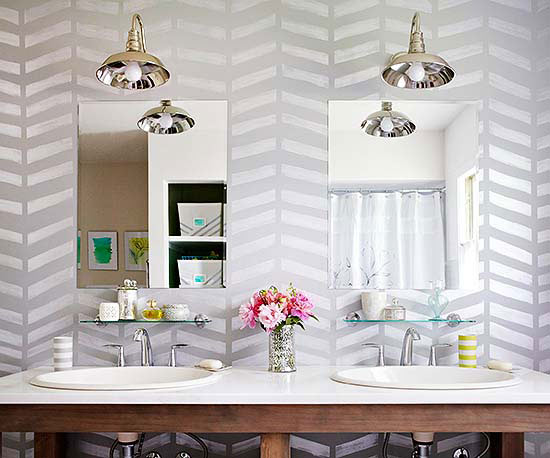
Geometric pattern on bathroom walls
Matte, gloss or texture
Manufacturers produce glossy and matte bathroom paints. When choosing a paint, you should pay attention to these visual effects, which give their nuances to the interior of the bathroom.
matte paints
The most versatile is the matte surface, which allows you to hide irregularities. It looks good in any interior. This coating has no reflection effect, thanks to which all minor repair errors are hidden. As a rule, matte bathroom paints are applied in one layer, which is quite enough to cover the color of the base. At the same time, it should be taken into account that dirt is clearly visible on a matte basis, which, moreover, is almost impossible to remove with a damp cloth. To do this, you will have to remove the old coating and repaint the damaged area. Therefore, when choosing a matte paint, the first thing to determine is how often the surface planned for painting will require cleaning.
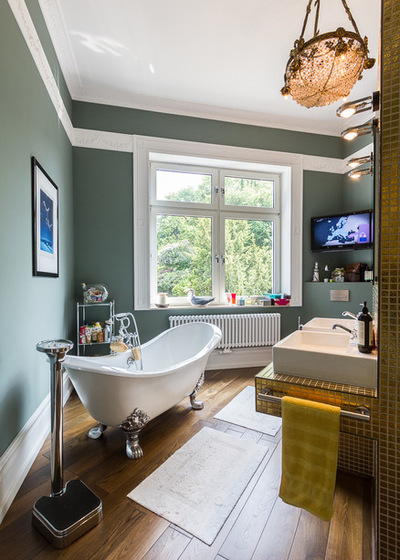
Matte bathroom wall paint
Glossy paints
The mirror effect of the glossy coating gives a shine, it looks much more elegant. A beautiful smooth surface helps to visually enlarge the small spaces of the room. Surfaces coated with glossy paints are easier to maintain and wash well. However, it can only be used on perfectly flat surfaces. Gloss will emphasize all the bumps and defects, so it is better to cover walls with flaws with matte materials.
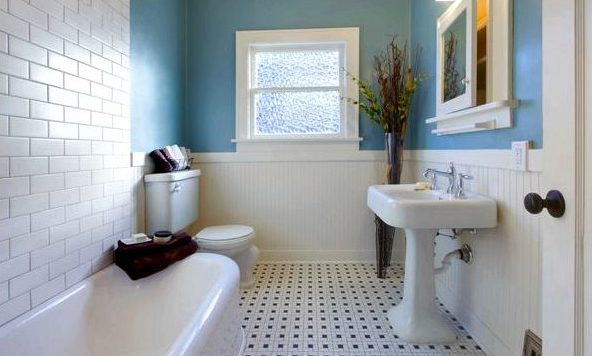
Glossy bathroom paint
Textured paints
Manufacturers offer embossed coatings for bathroom renovations that create a fine structure that hides defects and shortcomings in pre-treatment. Special paints based on acrylic and other components lie unevenly on the surface, creating a granular effect. Textured paints have many advantages:
- perfectly cover all the irregularities;
- easy to lay down, which allows you to easily paint the bath with your own hands;
- environmentally friendly;
- contains antifungal components;
- resistant to mechanical stress.
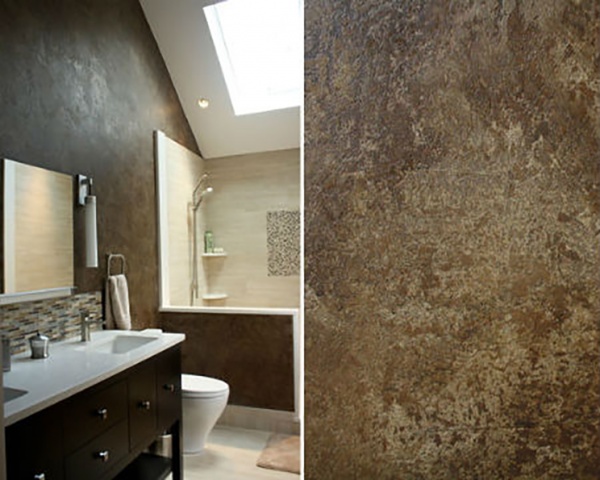
Textured paints are resistant to mechanical stress
Paint of any kind must be purchased in specialized stores, since only there are warehouses with the necessary storage conditions for building and finishing materials. When buying, be sure to look at the expiration date of the materials and focus on the image of the manufacturer of paint and varnish products.
back to index ↑Paint in different styles
Painting the walls in the bathroom goes well with all interior styles. Painted walls look impeccable in a classic bathroom design. This style welcomes such a design without limiting the owner to colors and textures, besides, the classic never goes out of style.
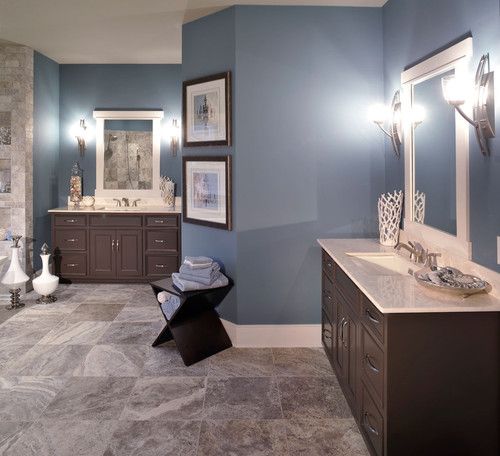
Bath wall paint fits perfectly into the classic style
The popular and fashionable high-tech style prefers the gloss of strict, cold shades. Different shades of gray and blue colors will perfectly fit into the bathroom decorated in this style. Weightless shelves made of glass will look great on such walls.
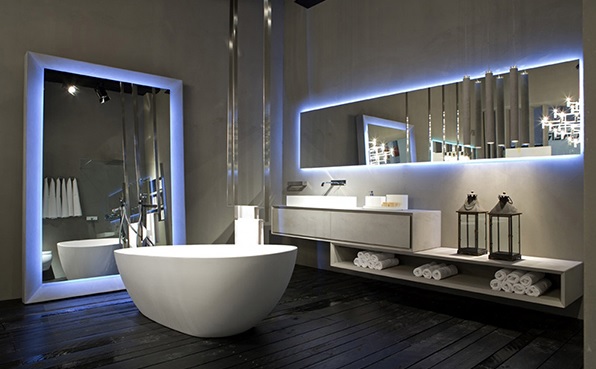
Cool colors are suitable for a high-tech style bath
Gives originality to the interior of the bathroom provence style. Delicate pastel shades of bathroom paints are ideal for decorating in the spirit of the French village: lilac, pink, beige and others. At the same time, the covering of the bathroom walls is made matte, using hand-drawn ornaments with floral motifs for a change.
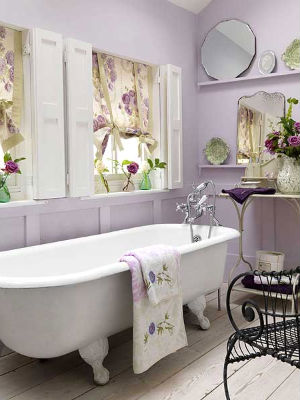
Matte pastel bathroom paint in Provence style
Bright, unusual colors on wall surfaces are perfect for a pop art or art deco style bathroom. Originality and zest will bring drawings borrowed from comics, or just cheerful pictures.
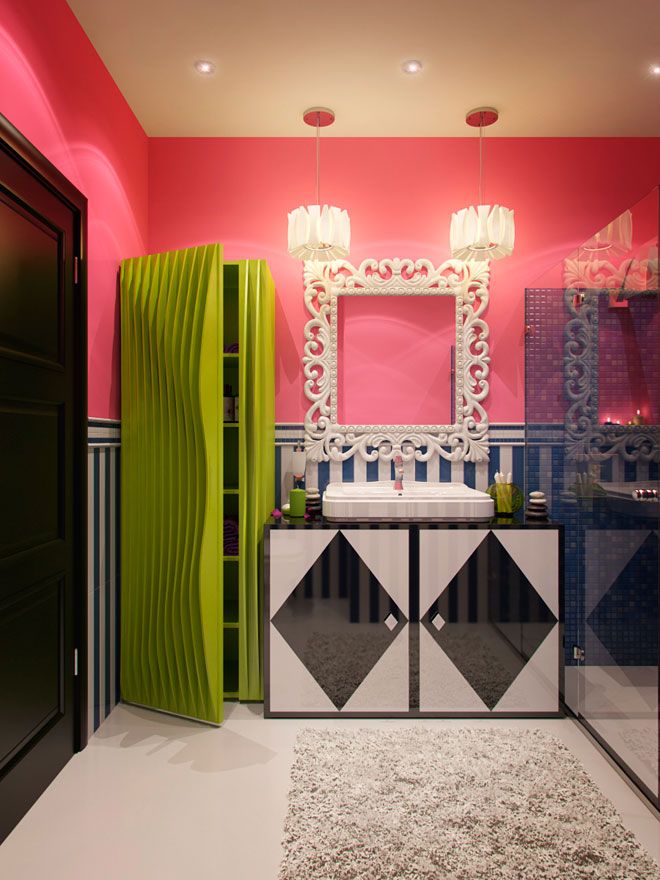
Bright colors of the bathroom in the style of pop art
How to paint yourself
The paint for the bathroom is selected, the design is thought out. You can start repair work. At the first stage, before you paint the bath with your own hands, you will have to carefully prepare the surfaces. Naturally, they begin with the removal of the old coating: removing tiles from surfaces, removing peeling plaster, washing off old oil or alkyd paint with special solvents.
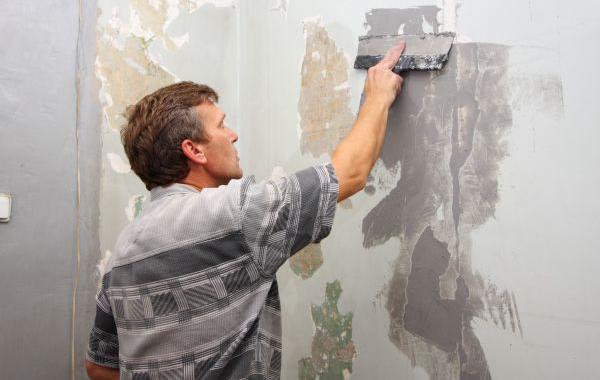
Before painting, the surface of the walls is cleaned
After that, they begin to level the walls and ceiling with the help of finishing putty. For the bathroom, you should take a cement-based putty. Before applying the first layer of coloring material, the surfaces must be treated with a primer. When selecting primer mixtures for the bathroom, attention should be paid to their waterproofing and antibacterial characteristics. To give the penetrating primer antiseptic properties, some experts advise adding a little copper sulfate or liquid chlorine bleach to it.
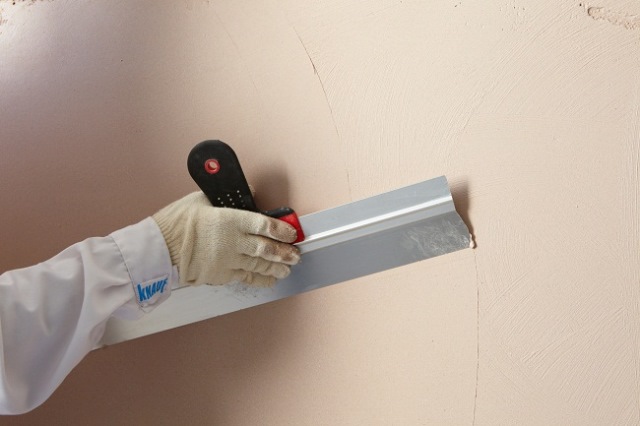
Application of finishing putty
After applying the primer, the surfaces must dry for at least 12 hours, and only then can you safely paint the walls in the selected color using special tools. Some types of paints and varnishes are applied in two or three layers, allowing the first to dry completely. First of all, carefully paint over all the corners and hard-to-reach places, and go to the next wall only after completely painting the first one. To create geometric patterns on the wall, masking tape or adhesive tape is used.
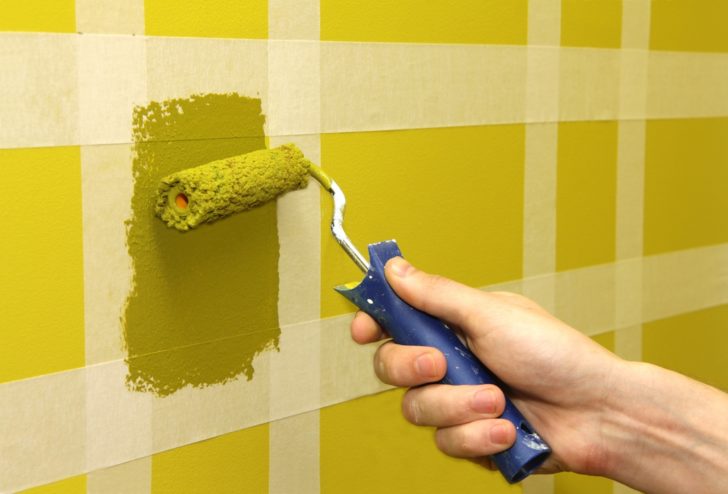
Drawing with masking tape
It is not difficult to paint a bath with your own hands if you strictly follow the rules of the preparatory stage, which is the key to high-quality finishes with a long service life. Paint is one of the most budget-friendly, great-resulting ways to completely update your bathroom design.
back to index ↑Photo gallery - bathroom paint
Video
